I am looking for any leads as to whether hunting bows from late 14thC had lashed or pinned nuts, specifically those shown in the Gaston Phebus books. 15th, 16th and 17thC hunting bows almost invariably had lashed nuts and so I would assume that it went earlier as well, but any ideas? I assume this but the pictures in Gaston Phebus don't show lashing so I am a bit lost.
Thoughts and pictures would be appreciated
Regards
Tod
I just pulled my copy of Gaston Phebus and looking at fol. 114, the mounted crossbowman on the far left may have a bound in nut. It appears to me that the lines across the stock would indicate lashing. On fol. 115 the crossbowman with the bow resting on his shoulder also appears to have something wrapping under the stock in the position of the nut.
There are many manuscripts od Gaston Phebus's Le Livre de la Chasse. The book of hunting was written in the 1380's and existing manuscripts were produced mostly in the 15th and 16th centuries. The most widely viewed ms resides in the Bibliothèque nationale de France codex - Français 616. Based on the folio #s, I believe that this is the manuscript Jason refers to. Français 616 was produced in Paris c 1423.
Another copy of the manuscript can be seen at the Morgan Library in NYC. This one was produced in 1407, also in Paris. I'll attach some crossbow details that I took from http://themorgan.org/exhibitions/exhibition.asp?id=2. I can see nothing that would suggest lashing of the prod/bow or nut.
 Attachment: 52.26 KB
Attachment: 52.26 KB
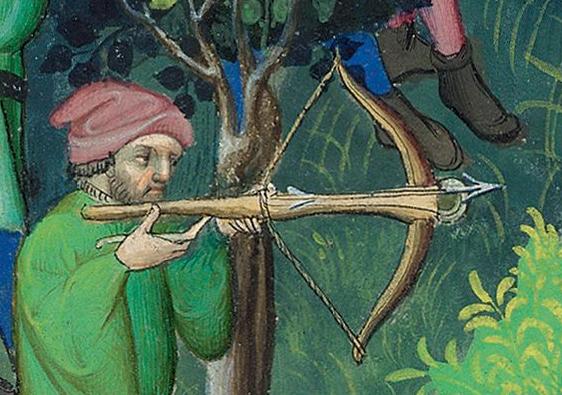
 Attachment: 64.14 KB
Attachment: 64.14 KB

 Attachment: 57.04 KB
Attachment: 57.04 KB
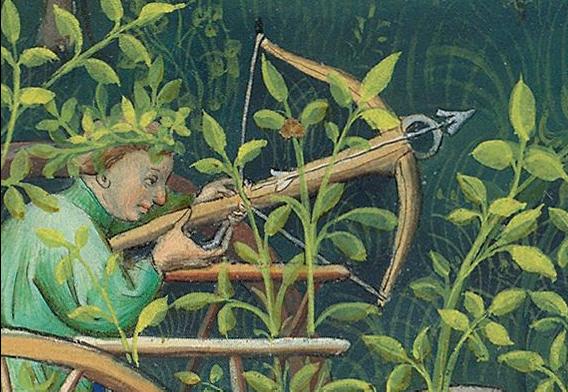
 Attachment: 53.69 KB
Attachment: 53.69 KB
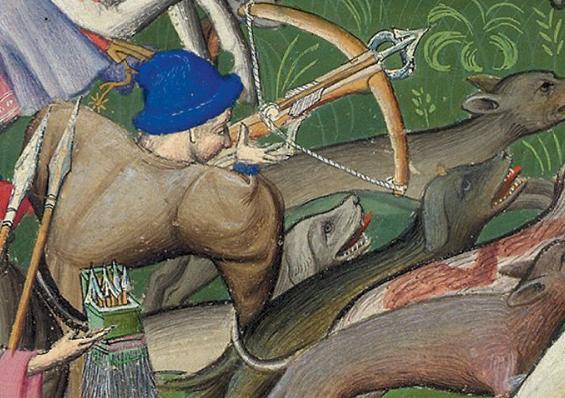
Another copy of the manuscript can be seen at the Morgan Library in NYC. This one was produced in 1407, also in Paris. I'll attach some crossbow details that I took from http://themorgan.org/exhibitions/exhibition.asp?id=2. I can see nothing that would suggest lashing of the prod/bow or nut.




Ed,
You are correct, my copy is of BNF FR 616, but now that I have pulled it off the shelf and double checked it, I should have referenced fol. 113v and fol. 115. The huntsman in green at the far left here, http://www.bnf.fr/enluminures/manuscrits/aman10/i5_0074.htm and again in green at the top with the crossbow over his shoulder here, http://www.bnf.fr/enluminures/manuscrits/aman10/i5_0077.htm or, it may be a case of seeing what I want to see, I would value other opinions.
You are correct, my copy is of BNF FR 616, but now that I have pulled it off the shelf and double checked it, I should have referenced fol. 113v and fol. 115. The huntsman in green at the far left here, http://www.bnf.fr/enluminures/manuscrits/aman10/i5_0074.htm and again in green at the top with the crossbow over his shoulder here, http://www.bnf.fr/enluminures/manuscrits/aman10/i5_0077.htm or, it may be a case of seeing what I want to see, I would value other opinions.
| Quote: |
|
Ed T wrote I can see nothing that would suggest lashing of the prod/bow or nut. |
In fact these show no method of holding the bow, stirrup or nut at all, as no lashing or bow irons or pins or bolts are shown at all. So discounting magic, it means that whatever method of attachment is being used is not shown.
The prodds are clearly not steel and I would read as composite and as far as I know these were always lashed rather than fixed by bow irons and that stirrup form also suggests lashing of the prodds to me. So I would swear blind that the prodds are lashed, but it is not shown - so where does that leave us with the nuts?
Leo,
As to the binding of the prod and stirrup, the second image posted by Ed seems to show a stylized hole with binding coming from it. It is blended in with the stock colour but does appear to me to be quite visible, and the shape visible lends itself to my interpretation. The artist has not shown the material wrapping around the prod & stirrup, but then again medieval artists had other concerns than technical accuracy of every physical object. It would be nice if somewhere out there there was a medieval R. Caton Woodville waiting to be dicovered, it would make everyone's life easier.
As to the binding of the prod and stirrup, the second image posted by Ed seems to show a stylized hole with binding coming from it. It is blended in with the stock colour but does appear to me to be quite visible, and the shape visible lends itself to my interpretation. The artist has not shown the material wrapping around the prod & stirrup, but then again medieval artists had other concerns than technical accuracy of every physical object. It would be nice if somewhere out there there was a medieval R. Caton Woodville waiting to be dicovered, it would make everyone's life easier.
I scanned some pages from my own book of BNF FR 616 images. Folio numbers were not provided but I'm sure the attached images are among those cited by Jason. If you look closely you can make out the bow lashings in some of the images. In the picture which shows the crossbow being carried over the shoulder and in the one where the cb is being reloaded there are lines that very well could inticate lashing for the nut. It is interesting to see what look like horn knocks on some of the bows and I wonder what the cross hatching seen on some of the crossbows signifies? Perhaps a covering over composite construction?
 Attachment: 82.79 KB
Attachment: 82.79 KB
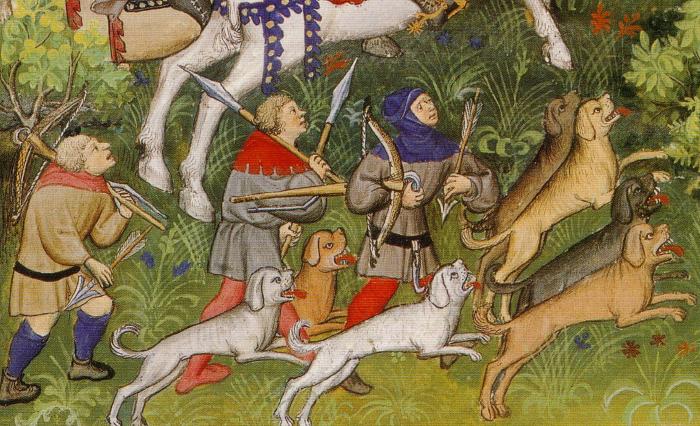
 Attachment: 127.01 KB
Attachment: 127.01 KB

 Attachment: 80.33 KB
Attachment: 80.33 KB
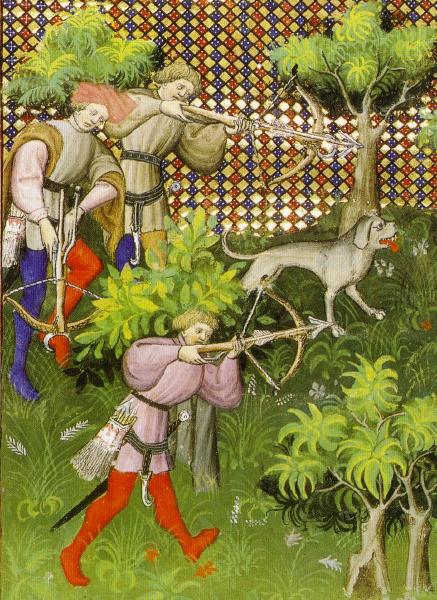



Ed,
The images that you have most recently posted are fols. 93, 113v, and 116 respectively.
As for the cross hatching that you noted I have seen it, or something like it in several illustrations. I am guessing it is either an artistic convention to represent a composite bow construction as opposed to simple wood or steel, or a cover of some type. Later crossbows often survive with a cover of some material over the prod, so I think it likely here as well. Illustrated in "Crossbows in the Royal Netherlands Army Museum" as Cat. No.19/Inv. No.11464 is a mid fifteenth century composite crossbow that has a cover of printed birch bark with a decorative pattern that would most easily be illustrated as crosshatching. This prod has the nocks painted in a dark colour as well, so that could account for what appears to be horn nocks.
The images that you have most recently posted are fols. 93, 113v, and 116 respectively.
As for the cross hatching that you noted I have seen it, or something like it in several illustrations. I am guessing it is either an artistic convention to represent a composite bow construction as opposed to simple wood or steel, or a cover of some type. Later crossbows often survive with a cover of some material over the prod, so I think it likely here as well. Illustrated in "Crossbows in the Royal Netherlands Army Museum" as Cat. No.19/Inv. No.11464 is a mid fifteenth century composite crossbow that has a cover of printed birch bark with a decorative pattern that would most easily be illustrated as crosshatching. This prod has the nocks painted in a dark colour as well, so that could account for what appears to be horn nocks.
Thanks Jason and Ed,
I would say that those images conclusively show that the prodds were lashed and that there is also one that could certainly be interpreted as a lashed nut.
The inside of a composite bow construction was both not pretty in the sense of neat and nor was it very weather resistant so they always seemed to be covered with something and I have certainly heard of birch bark being used as this cover all the way out to Mongolia, so I guess there is something special about its' properties. I would guess that the crosshatching was indicating some kind of pattern or texture, quite possibly of bark.
Regards
Tod
I would say that those images conclusively show that the prodds were lashed and that there is also one that could certainly be interpreted as a lashed nut.
The inside of a composite bow construction was both not pretty in the sense of neat and nor was it very weather resistant so they always seemed to be covered with something and I have certainly heard of birch bark being used as this cover all the way out to Mongolia, so I guess there is something special about its' properties. I would guess that the crosshatching was indicating some kind of pattern or texture, quite possibly of bark.
Regards
Tod
This is an interesting thread!
I'm no expert re. crossbows, but could it be that some of the bows illustrated here do not have a nut?....but rather the simple peg arrangement.
I was of the opinion that the nut came into use with the heavier bows and those with wooden prodds could have the peg.
(Not sure where laminated bows fit in with this.)
I would be interested to know what you think.
Sir RPG in his book illustrated a few different release mechanisms,....I should dig it out and look at it again!
Richard.
I'm no expert re. crossbows, but could it be that some of the bows illustrated here do not have a nut?....but rather the simple peg arrangement.
I was of the opinion that the nut came into use with the heavier bows and those with wooden prodds could have the peg.
(Not sure where laminated bows fit in with this.)
I would be interested to know what you think.
Sir RPG in his book illustrated a few different release mechanisms,....I should dig it out and look at it again!
Richard.
| Quote: |
| Richard Hare wrote
but could it be that some of the bows illustrated here do not have a nut?....but rather the simple peg arrangement. |
There would have been rising peg bows around (I suspect) but these would have been pretty low grade items for birding or so. Gaston Phebus' hunting guys would have been pretty well heeled or working for those that were and would have state of the art gear, so they would have been rotating nut and indeed in about 100 years from this date the trigger system started to develop specifically for hunting and really just to provide a lighter trigger with more feel - just what we strive for today.
Regards
Tod
Leo,
The decoration on the crossbow that I mentioned is a series of dots that appear to be painted, in a diamond pattern, 9 dots per diamond. I cannot get a clean image off of my scanner, otherwise I would post the photo for you. As for the waterproofing properties of birch bark you would have to see it to believe it, besides the canoes made of it, here is a personal observation. Birch trees cut for firewood have to be split and stacked immediately after felling, otherwise the wood will never dry, but rot out from the inside, leaving nothing but soft punk inside of waxy bark. If you leave it for a year or two, the wood will have rotted away leaving you with birch bark rings that are still waxy and flexible.
The decoration on the crossbow that I mentioned is a series of dots that appear to be painted, in a diamond pattern, 9 dots per diamond. I cannot get a clean image off of my scanner, otherwise I would post the photo for you. As for the waterproofing properties of birch bark you would have to see it to believe it, besides the canoes made of it, here is a personal observation. Birch trees cut for firewood have to be split and stacked immediately after felling, otherwise the wood will never dry, but rot out from the inside, leaving nothing but soft punk inside of waxy bark. If you leave it for a year or two, the wood will have rotted away leaving you with birch bark rings that are still waxy and flexible.
Page 1 of 1
You cannot post new topics in this forumYou cannot reply to topics in this forum
You cannot edit your posts in this forum
You cannot delete your posts in this forum
You cannot vote in polls in this forum
You cannot attach files in this forum
You can download files in this forum
All contents © Copyright 2003-2006 myArmoury.com — All rights reserved
Discussion forums powered by phpBB © The phpBB Group
Switch to the Full-featured Version of the forum
Discussion forums powered by phpBB © The phpBB Group
Switch to the Full-featured Version of the forum